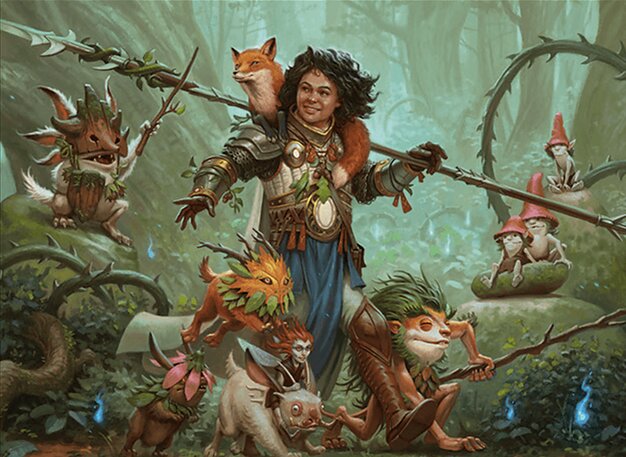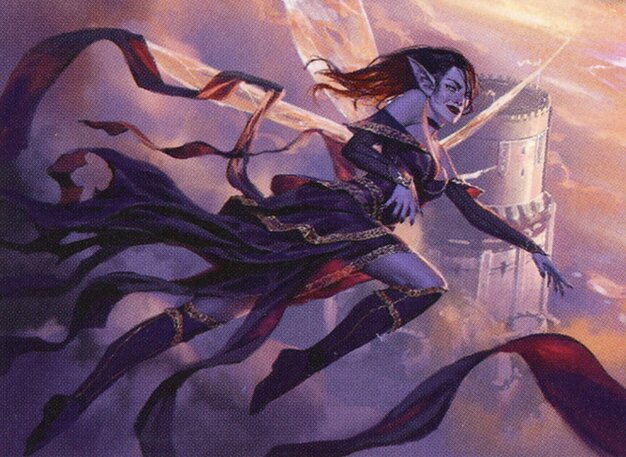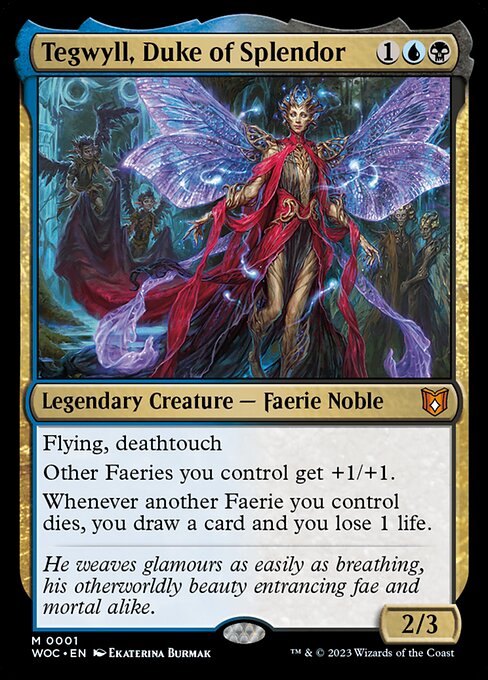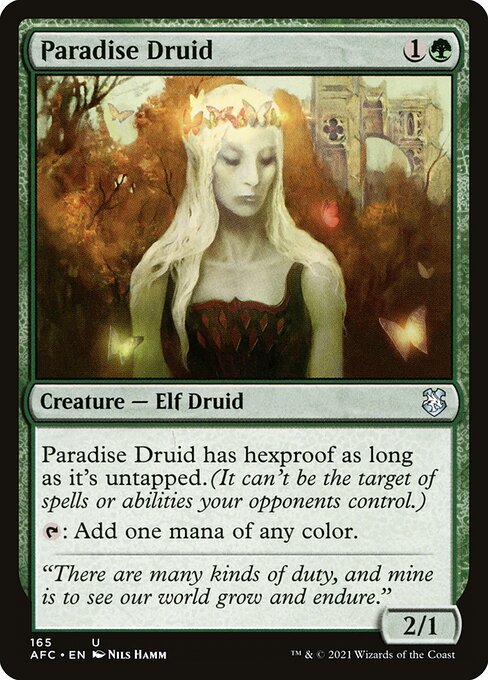Deck & Commander Strategies

Korvold, Fae-Cursed King
Use sacrifice outlets to grow Korvold's power and draw cards, generating overwhelming value and closing out the game through commander damage.

Ellivere of the Wild Court
Enchant creatures with rune tokens to boost their stats and draw cards on combat damage, leveraging aggressive enchanted creatures to pressure opponents.

Alela, Artful Provocateur
Cast artifacts and enchantments to create an army of flying fairy tokens, using air superiority and incremental damage to wear down opponents.

Tegwyll, Duke of Splendor
Build a flying fairy tribal deck that gains card draw whenever other fairies die, combining death touch and synergy to maintain board presence and advantage.
Gameplay Insights
- 1
Korvold’s player prioritized early sacrifice outlets to quickly accumulate +1/+1 counters and card draw, accelerating their board presence.
- 2
Ellivere’s use of Gilwain, Casting-Director to create multiple rune enchantments with Ward on a single creature provided strong protection and repeated triggers for card advantage.
- 3
Alela's deck aimed to leverage flying tokens created from casting artifacts and enchantments to establish air dominance and pressure opponents from above.
- 4
Tegwyll's deck capitalized on fairy tribal synergies, drawing cards whenever fairies died to maintain resources and board control.
- 5
Field of the Dead was used as a slow but steady token generator, setting up a long-term board presence.
- 6
Players focused on building synergistic boards early rather than immediate aggression, indicating a midrange tempo battle.
Notable Cards
-

Korvold, Fae-Cursed King
-

Ellivere of the Wild Court
-

Alela, Artful Provocateur
-

Tegwyll, Duke of Splendor
-

Paradise Druid
-

Field of the Dead
-

Wayfarer's Bauble
Gameplay Summary
The game featured a four-player Brawl format clash on the Eldraine plane, with a mix of original and new pre-con commanders.
Korvold, Fae-Cursed King leveraged its sacrifice synergy to grow in power while drawing cards, aiming to overwhelm opponents through incremental advantage and commander damage.
Ellivere of the Wild Court focused on enchanting creatures with various rune tokens to boost stats and draw cards through aggressive combat.
Alela, Artful Provocateur built a flying fairy army by casting artifacts and enchantments, seeking to dominate the air and chip away at opponents.
Tegwyll, Duke of Splendor, played a fairy tribal deck emphasizing flying creatures with death touch and card draw triggered by the death of other fairies, creating a resilient and synergistic board state. Early turns saw players setting up mana and board presence, with Korvold's player quickly establishing sacrifice fodder and card draw, while Ellivere's player worked on enchanting creatures to enhance damage potential.
Alela's strategy centered around generating a swarm of flying tokens to exert pressure, while Tegwyll's build focused on maximizing the value of fairy tribal synergies and incremental card advantage.
Key turning points included Korvold deploying sacrifice engines like Reassembling Skeletons, and Ellivere utilizing Gilwain Casting-Director to generate multiple rune tokens with Ward, protecting their critical enchantments.
The game’s pace was set by the interplay of flying threats and card draw engines, with each player working to establish board control through their unique synergies.
![Wilds of Eldraine pre-con brawl EP: 19 Korvold v Ellivere v Alela v Tegwyll [EDH gameplay] thumbnail](https://i.ytimg.com/vi/VwaZIOSZZNk/maxresdefault.jpg)

![Ep 1: Jarred v Jedit v Elas v Jaxis commander / [EDH gameplay] thumbnail](https://i.ytimg.com/vi/fOXepOqTRcA/sddefault.jpg)
!["Battle of the Commanders" EP: 2 Anje vs Zur vs Jedit vs Phabine [EDH Gameplay] thumbnail](https://i.ytimg.com/vi/ZmDQKhu_A_M/sddefault.jpg)
!["4 Player Commander Showdown "- Ep: 3 Hazezon v Dihada v Willowdusk v Raffine [EDH Gameplay] thumbnail](https://i.ytimg.com/vi/BiDOJLw7a3I/sddefault.jpg)
![All will be one! EP: 4 Prosper v Neyali v Ixhel v Karumonix [EDH gameplay] thumbnail](https://i.ytimg.com/vi/1rB3FW952-4/sddefault.jpg)
![Ep: 5 Tawnos v Yuriko v Purphoros v Urza [EDH gameplay] thumbnail](https://i.ytimg.com/vi/ovuvwBzAQ1U/sddefault.jpg)
![Ep: 6 Myrel v Liesa v Kess v Falco [EDH gameplay] thumbnail](https://i.ytimg.com/vi/Au02HpcLJGA/sddefault.jpg)

![Ep: 8 Xira v Atraxa v Goblinson v Akiri [EDH gameplay] thumbnail](https://i.ytimg.com/vi/vRfqRDjvoXs/sddefault.jpg)

![Knightly Showdown EP: 11 Gisa v. Imoti v. Sidar Jabari v. Syr Gwyn [EDH gameplay] thumbnail](https://i.ytimg.com/vi/P8KX_caip9U/sddefault.jpg)











![Commander VS S17E3: Korvold VS Alela VS Chulane VS Syr Gwyn [Brawl] thumbnail](https://i.ytimg.com/vi/Pa8JzkN1leY/sddefault.jpg)













